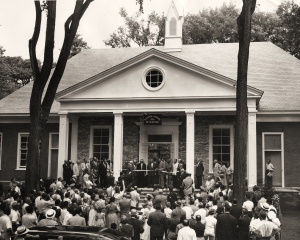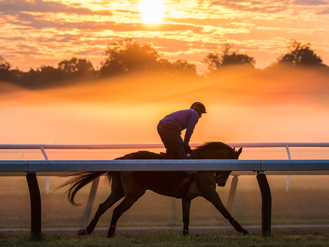Mission and History
Mission Statement
The mission of the National Museum of Racing and Hall of Fame is to preserve and promote the history of thoroughbred racing in America and honor the sport’s most accomplished participants in the Official National Thoroughbred Racing Hall of Fame.
National Museum of Racing and Hall of Fame History
By Edward L. Bowen
Led by Cornelius Vanderbilt Whitney, a group of people prominent within the sport of thoroughbred racing founded the National Museum of Racing in 1950. The Museum’s location of Saratoga Springs, N.Y., home of the oldest thoroughbred racetrack in America, proved to be an ideal setting.
On Aug. 6, 1951, amid a great deal of fanfare, the Museum made its public debut in a temporary location at the Canfield Casino in Congress Park.
“The long-range purpose,” Whitney said at the opening in the famous old casino, “is to build a permanent home for the important memorabilia for the sport whose beginnings in this country antedate by 100 years or more the United States of America.”
In 1955, the Museum moved to a newly constructed facility at 191 Union Avenue, directly across the street from historic Saratoga Race Course. Through the decades, the Museum has grown in size and scope and now occupies a sprawling building with some 45,000 square feet of space.
Joining Whitney in the founding group that signed the charter for the Museum were Carleton F. Burke, Kenneth K. Burke, John C. Clark, Nelson Dunstan, Donald P. Ross, F. Skiddy von Stade, John Hay Whitney, and George D. Widener, Jr. Also recognized as organizers of the Museum were Francis Dorsey, Spencer Eddy, Howell E. Jackson, Walter M. Jeffords, Robert F. Kelley, Paul Kerr, Addison Mallery, Denis Mansfield, Dr. Charles H. Strub, and Bryce Wing.
The first gift for the Museum project was $5,000 from the Saratoga Association, which owned and operated Saratoga Race Course. Harold O. Vosburgh, a steward for the Saratoga Association, donated the first piece of memorabilia, a shoe from the legendary horse Lexington.
Cornelius Vanderbilt Whitney served as the first president of the Museum from 1950 to 1953. He was followed by Jeffords, 1953 to 1960; Widener, 1960 to 1968; John W. Hanes, 1968 to 1970; Gerard S. Smith, 1970 to 1974; Charles E. Mather II, 1974 to 1982; Whitney Tower, 1982 to 1989; John T. von Stade, 1989 to 2005; Stella F. Thayer, 2005 to 2014; Gretchen Jackson, 2014 to 2017; John Hendrickson from 2017 to 2024; and Charlotte Weber from 2024 to present..
The Museum was popular from the beginning. During its first year of operation at the Canfield Casino in 1951, the Museum attracted more than 8,000 visitors. At the end of 1952, the register showed 11,500 names.
When it was announced the Museum would move out of its original quarters in the Canfield Casino into a structure being built specifically to house it, a Saratoga citizen, James E. Benton, applauded. He sparked some of the impetus toward a Hall of Fame with a letter to journalists Nelson Dunstan and Gene Ward. He made an eloquent plea, noting that some aspects of Saratoga were changing — the demise of the Grand Union and United States hotels, for example — but that tradition was an important part of the area and racing.
“If a board of turf writers, for instance, were to elect annually to the Hall of Fame one or more jockeys, horses, or trainers, it would be of national importance,” Benton wrote. “An annual special award would be coveted.”
By early 1955, it was announced by Jeffords that the new building would, indeed, include a Hall of Fame. The Museum board had passed the following: “Resolved that the National Museum of Racing create and be custodian of racing’s Hall of Fame and its president be empowered to appoint a committee whose duties it will be to recommend to the board of trustees ways and means of selecting candidates.”
Given that thoroughbred racing had been a part of life in America since the colonial days, a bit of catching up was needed. It was decided that the first group of Hall of Fame inductees would be comprised of horses which had raced prior to 1900 and jockeys and trainers who were no longer active.
The inaugural class of inductees included the horses Ben Brush, Boston, Domino, Hanover, Hindoo, Kingston, Lexington, Salvator, and Sir Archy; jockeys Laverne Fator, Edward Garrison, Danny Maher, James McLaughlin, Walter Miller, Isaac Murphy, George Odom, Earl Sande, Tod Sloan, Fred Taral, Nash Turner, and George Woolf; and trainers William P. Burch, Thomas Healey, Sam Hildreth, A. J. Joyner, John Rogers, and James Rowe, Sr.
Ground was broken for the Museum’s permanent home during the final week of November 1954. The cornerstone was laid the following April and New York Gov. W. Averell Harriman presided over the formal dedication on Aug. 16, during the Saratoga racing season. Harriman spoke briefly prior to the ribbon-cutting ceremony.
“Racing must remain as a sport,” he said, “and not as a commercial enterprise. We must maintain the traditions of racing, and Saratoga is rich in such traditions.”
The National Museum of Racing opened to the public on June 2, 1956. The building was designed by New York City architect Augustus Noel. The New York Times’ report on the dedication said the building cost $300,000. In 1957, the first addition, called the Patrons of the Turf Gallery, was completed. More expansion followed. A third wing was added in 1979 and became the home of the Hall of Fame.
Until the mid-l980s, the Museum functioned primarily as a diversified set of galleries and was open only during the summer. The Museum then began evolving into a professionally managed institution. The Board of Trustees raised $6.4 million and hired an English design team experienced with thoroughbred racing to completely renovate the building and develop historical galleries covering three centuries of racing in America. The renovation took 10 months and the building reopened on July 14, 1988.
Between 1999 and 2000, a major renovation and a 10,000 square-foot expansion of the physical plant costing $18 million improved collections storage and created a changing exhibition space, a curatorial workroom, and a children’s gallery. The story line of the semi-permanent historical galleries also expanded to include 20th century history and current events in racing. Extensive audio and video presentations, as well as interactive exhibits for all ages, were added throughout the Museum.
During the past 20 years there has been tremendous change in all areas of Museum operations. The unique horse racing simulator was developed and opened to the public in 2006; a new interactive Steeplechase Gallery opened in 2012; the Museum celebrated 150 years of racing at Saratoga with a two-year exhibit that opened in June 2013; in 2016, the Museum opened the Edward P. Evans Gallery, which displays some of the most coveted and prestigious trophies in the history of American racing; and in 2018, the Museum unveiled its renovated courtyard, named in honor of Cornelius Vanderbilt Whitney.
The Museum continues to evolve. In 2020, the new Hall of Fame Education Experience opened to the public. The $20 million project includes a new immersive signature film and state-of-the-art interactive Hall of Fame plaques for all 487 inductees.
As the Museum changes with the times, it continues to be a dynamic and integral part of the vibrant game it celebrates. Its core mission — to chronicle and promote the rich history of one of America’s most spectacular sporting pastimes through educational experiences — continues to inspire racing fans and cultivate new ones.
Written by Edward L. Bowen, an Eclipse Award-winning journalist and the author of more than 20 books on thoroughbred racing. Bowen was the Hall of Fame Nominating Committee’s chairman from 1987 through 2024. He passed away in early 2025.





